PART 1
There are many reasons that you may want to gain the trust of a feral cat, but the process is not as easy as you may think. Before proceeding, you should be aware of the high probability that your feline friend will never allow you to touch it. These animals are not quick to trust, so you will need to be very patient in order to succeed in bonding with them.
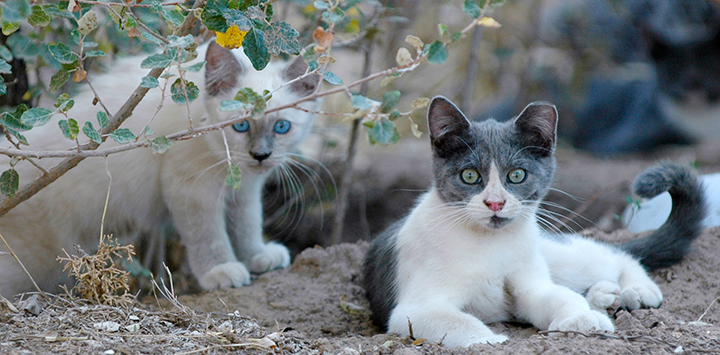
First, let’s clarify exactly what we mean when we refer to cats as “feral”. This designation is often confused with “stray”, but the two terms are very different. A stray is simply a domesticated cat that has become separated from its home for one reason or another. A feral cat, conversely, looks just like a domestic cat, but has not experienced human contact. Its behavior will be similar to that of a raccoon or other wildlife.
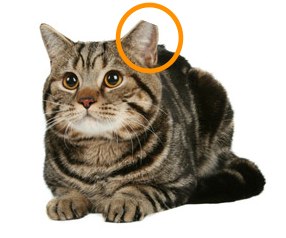 Aside from behavior differences, you may be able to identify a cat as a pet if you see a collar or a well-groomed coat. Feral cats, on the other hand, can sometimes be identified by a missing sliver of ear. The “tipped” ear indicates that the cat has been spayed or neutered by a volunteer group, then released.
Aside from behavior differences, you may be able to identify a cat as a pet if you see a collar or a well-groomed coat. Feral cats, on the other hand, can sometimes be identified by a missing sliver of ear. The “tipped” ear indicates that the cat has been spayed or neutered by a volunteer group, then released.
Before attempting to befriend a feral cat, be sure that you understand what you’re getting yourself into. You should be aware of some potential problems and risks associated with welcoming an untamed animal onto your property.
Just like any wild animal, feral cats will defend themselves if cornered. Moving too quickly with one of these cats could result in being scratched or bitten. Wounds from cats often become infected, hence the term “cat scratch fever”.
Stray and feral cats may carry a disease called Feline Leukemia Virus. This fatal disease cannot be detected by sight and is contagious to non-vaccinated cats.
Feral cats may also become territorial over their newfound retreat, and urinate, scratch vertical markers, or even chase away “intruders” as a result.
Now that you’re aware of the dangers of cozying up to a feral cat, it’s time to get to work. The first step is to create a place that will seem attractive to a feline friend. Feral cats are focused on survival, so they will surely seek out food, water and shelter.
Choose an area within your property that will serve as your hangout spot. This needs to be a quiet space that you can monitor from inside your home. You’ll need to be able to spend hours at a time in this spot, so comfortable outdoor furniture or a camping chair is a plus. Whatever the item is, it should be introduced to the area from the beginning.
Start leaving food and water in your designated area while no one is home, at least 50 feet away from the door (and your chosen seat) if possible. While dry cat food will often do the trick, you may want to consider a more fragrant food to attract cats more quickly. Some feline favorites include canned cat food, baby food, canned tuna in oil, sardines, and of course, catnip.
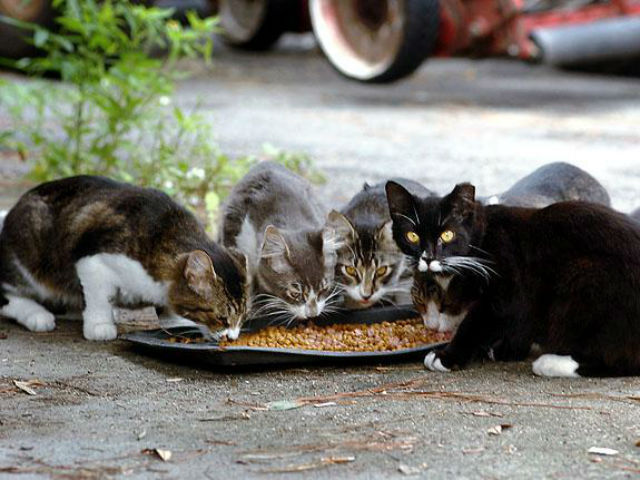
Once the cat smells food and realizes that the coast is clear of predators, he will most likely drop by for a bite. This will put your house “on the map”, and in Kitty’s daily routine. Keep in mind that by leaving food out unattended, you could attract other wildlife that may not be so desirable.
Continue to leave food out for the cat for 3 to 4 days, allowing him/her to acclimate to the space with no human interference. After this time is up, you can add yourself into the equation. Begin putting food out only while you are home, but inside, so that the cat can smell you.
After allowing the cat to eat with you on the other side of the door for a few days, try doing the same, but with only your screen door (weather permitting) separating you from the cat. If the cat appears to accept this routine, it is time to sit outside while he eats.
Written by Jonas Jurgella, Animal Communication Scientist and author of the Cat Language Bible – How to finally understand and speak wth your cat.

BONDING WITH A FERAL CAT PART 2
Don’t be surprised if the cat doesn’t show up for food on this day- he is unsure of your intentions and is probably watching from a distance. The key is to be patient. Spend a few hours in the chosen area, doing your best to look non-threatening. This means that you should be still and quiet, even if you don’t see the cat. It’s also very important that you do not go looking for it at this point. All you’ll do is scare it.
After a few days of this routine, your feral friend should gain some confidence. If he does approach the food with you in the area, you’re doing a great job! If and when the cat approaches, you’ll want to continue exactly as you were, almost as if you don’t see him. This shows the cat that you aren’t a threat.
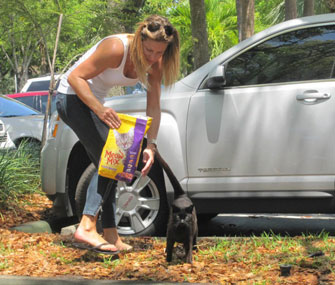 For each of these steps, you must settle into your space before the cat arrives, and remain there until he leaves. Any movement can scare your new pal away for good. You should only move the bowl closer every few days if the most recent progress has been accepted. If the cat stops showing up, or is visibly afraid, slow the process down until he seems comfortable. Follow this pattern until the cat reaches 10 or so feet from your chosen sitting area.
For each of these steps, you must settle into your space before the cat arrives, and remain there until he leaves. Any movement can scare your new pal away for good. You should only move the bowl closer every few days if the most recent progress has been accepted. If the cat stops showing up, or is visibly afraid, slow the process down until he seems comfortable. Follow this pattern until the cat reaches 10 or so feet from your chosen sitting area.
If, at any point, you don’t see your feline friend for a couple days, withholding food for up to 48 hours may leave him desperate enough to give you another chance. You shouldn’t let him go hungry any longer, nor should you ever withhold water, as this may cause Fluffy to look elsewhere.
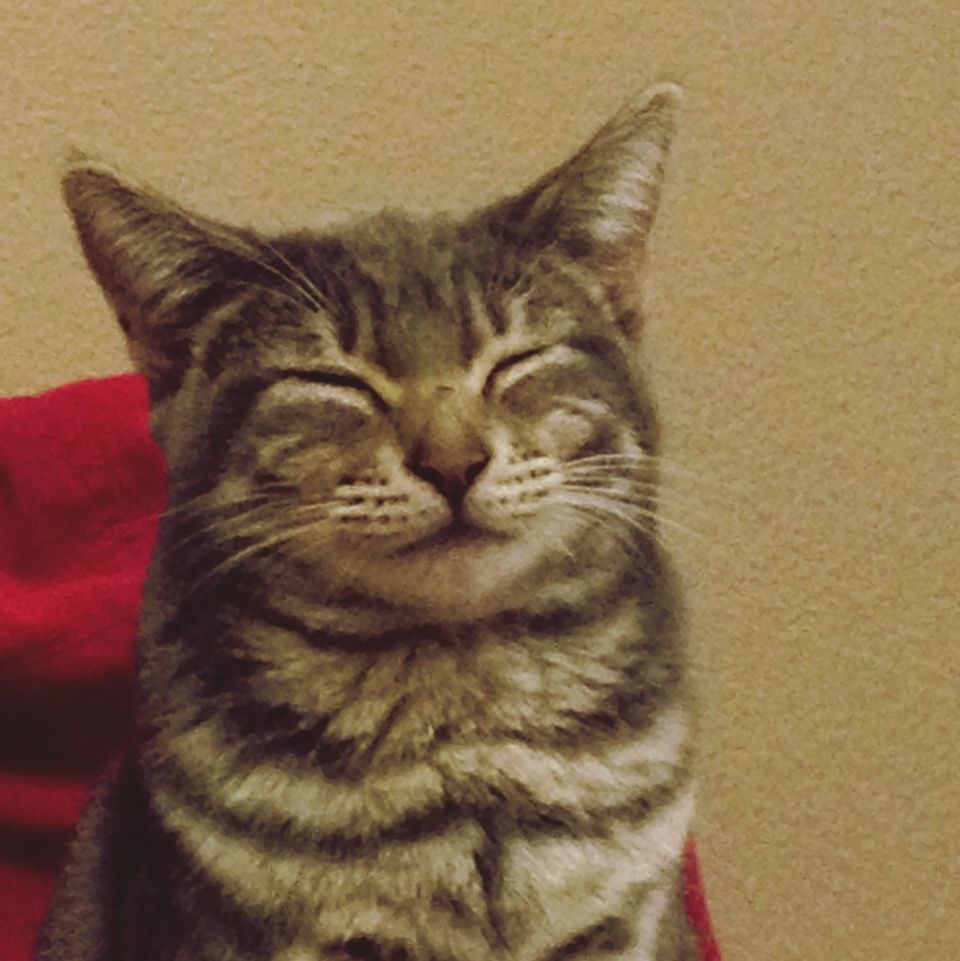 Once you’ve gotten into the routine of sharing space with the cat, the best way to improve the relationship is to understand body language. There are plenty of resources on cat communication, focused primarily on eye, ear, and tail movement. You can even try to communicate trustworthiness to your kitty companion by slowly blinking at him. In the cat world, this is a way of acknowledging an acquaintance while expressing that you are not a threat.
Once you’ve gotten into the routine of sharing space with the cat, the best way to improve the relationship is to understand body language. There are plenty of resources on cat communication, focused primarily on eye, ear, and tail movement. You can even try to communicate trustworthiness to your kitty companion by slowly blinking at him. In the cat world, this is a way of acknowledging an acquaintance while expressing that you are not a threat.
Many feral cats will not let their human caregivers get within reach of them, even after months of companionship. This does not mean that they do not share a special relationship. You may continue to bond with your feral friend for years to come by simply enjoying each other’s company. Some cats may even play with a laser pointer- just be sure not to move too quickly!
Bonding with a feral cat can be extremely rewarding. Earning the trust of a wild animal is an honor that not many people have had the fortune to experience. The process can be tedious and frustrating, but with an abundance of patience and understanding, you can do it!
Written by Jonas Jurgella, Animal Communication Scientist and author of the Cat Language Bible – How to finally understand and speak wth your cat.


I have a bunch of feral cats that live in my house. One of them, Tiger, sleeps on my bed with me every night. His sister (yes, REAL sister) Booties often does the same, only she usually sleeps by my feet (like she did last night). Sometimes Tiger’s brother Blacky sleeps on the bed, too. The two brothers also love my lap…a lot. Their mum Patches lives here, too. Patches had her kittens behind my shed. After she brought them out into my back yard, I took the whole lot of 4 into my house. Yes, Patches was ready for it. This was 6 years ago now.
About 2 years ago, another feral, Tabby, joined us. He has always been a bit more aloof, but, he often comes when it is chowtime, and he DOES allow me to touch him. Tiger quickly became buddies with him. They even slept in a box together.
In April of last year, Tabby’s older sister, Midnight the Feral (now Midnight the Feral Queen of the Office) was lured in (exact same trick as I pulled on Tabby). Earlier that day, she had put her 2-day old kittens in front of my back door that I came out of to feed the outside cats. They needed help and she knew it. Of course, I took them in. Later, she was looking for them, so I lured her in, stuffed her into a cat carrier (she was NOT happy at this point) and brought her into the office. Her attitude completely changed when she saw I was reuniting them. 10 months later…two of her kittens are still here (one didn’t make it, another fell down and died a few months ago) and have been neutered. Their mum? Yes. She was TNRed. However, her “return” was not what most people would associate it with. She was returned back to the office. You see, in her case, during all the time between April and January, Midnight the Feral had not tried, even once, to leave. In fact, when I brought her back into the office and uncovered the trap, she actually looked at me and started meowing. Not to mention that back in October, she actually started being ok with me touching her. She just LOVES being with her kittens, even though her son Vader is bigger than her now. She also has her own house (large Amazon box with a hole cut into it). She often goes in there to sleep (which she is doing right now), but other times she sleeps in other places in the office, like her chair (or mine if I’m not on it), or the corner piece, or even on the window sill. Her house is also her “go to” place when I have visitors. She just waits till they leave.
A few months ago, another cat showed up. Midnight’s older daughter Spots decided she wanted to be a house cat. Spots would always greet me either at my gate or by my front door whenever I came home in the evening. If she wasn’t there already, she would come RUNNING as soon as she realized I was here. For a long time, she would come in to eat 2x a day, then wait patiently for me to let her out. But, then she wanted to stay, so after a few overnight stays (every night), I finally just said “why don’t you just live here full-time? She said “yes”. Every morning and every night she is in that one spot in the living room where she gets her cans of cat food. She has taken a liking to her uncle Tabby and his best friend, Tiger. She has always gotten along well with Booties (who was cursing at Tabby for over a year after he joined us). I didn’t know it, but, she was pregnant with two. She gave birth about a month later to Scraps and Pieces (they looked like her) because they looked like they were made with scraps and pieces of different materials. Sadly, they died about a month later, but, I tried to save them, especially Pieces. I just didn’t have enough time. 😦 The plan is to get Spots neutered as well.
Is it possible to bond with a feral cat? Yes. Is it easy? No. It is a VERY difficult thing to do. I knew Spots early on, her mum Midnight would bring her to eat. Her brother, Shadow came in along with Midnight (Spots wasn’t ready yet), but, he died. He had something wrong and was very thin. He died before I could get him to a vet. 😦
LikeLiked by 1 person